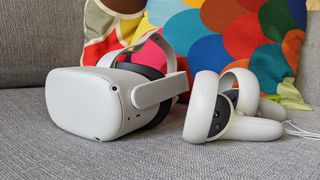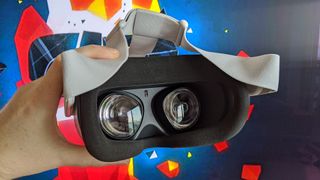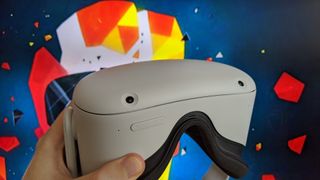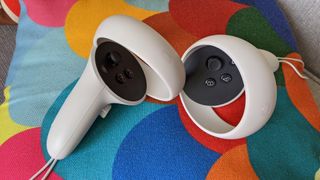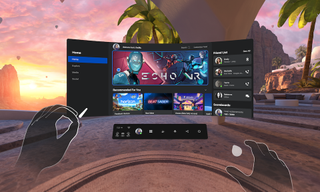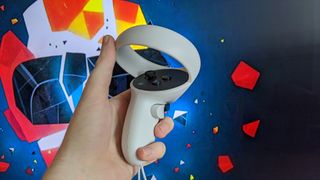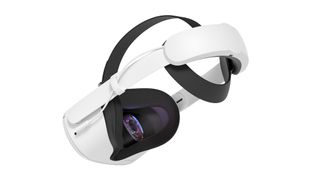Two Minute Review
If you’re looking to buy a VR headset, and don’t have the money for the best-of-the-best PC-based Valve Index setup, you should buy the Oculus Quest 2. This mobile VR gadget offers easy access to exactly what makes VR so special, offering high-quality virtual reality experiences at a fair price.
Allowing you to literally step around inside gaming worlds, as well as access 360-degree video content and apps, Oculus Quest 2 is an immersive gadget that even the most tech-shy members of your family can have a blast with.
It remains very similar to the original Oculus Quest – being a battery-powered, standalone headset that allows you to freely roam around your physical and digital play spaces without fear of tripping up on a wire. And that’s no bad thing – the Quest is a welcoming and accessible entry point to the thrills of virtual reality, and it works wonders straight out of its box.
Some things have changed though – it’s a more responsive experience overall, thanks to improved RAM and chip specs, and a higher resolution display that’s 50% sharper than its predecessor. Developers now have the option to make their games run at 90Hz (important for increased comfort and realism while playing), and the headset itself is lighter than before, too. Hand tracking – which came to the original Quest via a firmware update, but is baked in to the Quest 2 from the off – is also impressive, though clearly still a work in progress.
It comes with two controllers (now offering double the battery life of their predecessors), and offers hundreds of separately-sold games – and some free ones too. From shooters to puzzle games, fitness titles to meditation apps, there’s something for everyone, even if levels of quality – and comfort – can vary.
Quest 2 is also a social experience. Though some will shudder at the newly-introduced Facebook account requirement, Oculus Quest 2 is superb when playing with friends, whether through online avatars, or in the same physical room thanks to the option to Google Cast whatever you’re viewing in the headset to a nearby display.
And yet. While Quest 2 is the most accessible and feature-rich VR headset to date, it still falls foul of some of the pitfalls that virtual reality as a whole market suffers from. There’s still the chance you’ll experience a degree of motion sickness, depending on your constitution, and getting a good tight fit to make the screen clear can be claustrophobic and uncomfortable. These base-level issues remain unsolved; for a new generation of hardware, we’d have liked to have seen a wider array of brand-new software to go with it, too.
If you can get over those hurdles, though, there’s nothing quite like the thrill of VR. Games like Robo Recall and Beat Saber should still amaze, and, in an age of social isolation, turning YouTube VR into your own personal IMAX screen is a welcome distraction from the madness of the outside world.
Oculus Quest 2 isn’t perfect, then – but it’s as close to perfect as VR has come so far.
Price and Availability
Oculus Quest 2 comes in two variants: a model with 64GB of storage, priced at £299 / $299, and a 256GB version for £399 / $399. Pre-orders are open now through the Oculus website, with general retail availability opening up on October 13, 2020.
That’s a significant saving over the price that the original entry-level Oculus Quest model opened sales at. It’s not cheap, but considering it’s a contained experience that doesn’t require a PC, console or even an additional screen in order to work with it, it represents great value.
Design
- Self-contained VR headset
- Improved resolution screen and processor
- Controllers have double battery life and thumb rest spaces
The Oculus Quest 2 is worn on the head, quite a bit like a scuba mask. Where a scuba mask’s window would be, you’ve instead got a padded cavity that houses a pair of goggle-like lenses that sit in front of a screen, giving you stereoscopic 3D visuals. Paired with motion sensors and accelerometers in the headset, you can move your head and see the motions reflected in the digital screen, as if you were looking out and moving around in the real world.
It’s a similarly lightweight design to the first Oculus Quest (now in a white plastic rather than a dust-hugging, fabric-covered black) with its outer shell housing external cameras that help to track your positioning and that of the supplied controllers. You tighten the headset with a velcro, slightly-elasticated fabric strap – a change (not necessarily for the better) from the more structured rubberised original.
The internal improvements are significant. Compared to the original Quest, the Quest 2 offers 6GB of RAM compared to 4GB, and there’s a much faster Qualcomm Snapdragon XR2 chipset running the show. This allows for greater fidelity in experiences shown on the Quest 2, as well as allowing for boosted resolutions and refresh rates.
The first Oculus Quest made use of dual 1440 x 1600 resolution OLED displays (one for each eye), but the Quest 2 opts for a single LCD panel, split so as to display an 1832 x 1920 pixel resolution per eye. That’s about 50 percent sharper than the original, and while we’d usually prefer the richness of an OLED display, we hardly missed it here. LCD also opens up an improved refresh rate of 90Hz to developers, compared to the original Quest’s 72Hz. Where currently supported, it’s a notably smoother experience.
Note though that there’s a change to the Interpupillary distance (IPD, the gap between your pupils) slider on the Quest 2. Previously, you could make fine adjustments with a slider on the underneath of the original Quest. Now you have to physically shift the goggles themselves over three pre-set distances, 58mm, 63mm and 68mm. While most won’t notice any difference (the three settings cover the most common IPD ranges), it’s a shame that more delicate control has been lost.
The Quest 2 does all of this while still offering the same 2-3 hour battery life as the first Quest, depending on the application you’re using. That may not sound like much, but longer play sessions than that are unlikely to be comfortable anyway. Oculus has managed this thanks to significant improvements to its tracking algorithms, which extend to the controllers too, now offering double the battery life (we’re talking weeks of constant play) compared to their predecessors.
The motion controllers themselves have seen some small improvements too. Now available in white, they offer more room to rest your thumb during play, making them easier to hold for longer sessions. Each has a baton-like handle, including triggers for your forefingers and grips, as well as facial buttons and movement sticks for your thumbs. A strap keeps the controllers from flying free from your hand, while a plastic ring surrounds your thumbs, housing the near-invisible LEDs that allow the headset to track your hands’ and arms’ movements.
Speakers are built into the headset’s strap supports, offering directional left and right stereo sound. They’re reasonably clear and loud enough to get across the drama and directional audio feedback of your games, while keeping your ears free in order to allow you some awareness of your physical surroundings. Note that if you’re playing in a room with a friend, they’re going to hear everything going on using the built-in speakers, but there’s also a 3.5mm jack if you want to connect your own headphones for a private session.
A microphone is built in too, again clear enough for communicating in multiplayer games and doing some voice searches in the various UI elements of apps that support it. Speech recognition is surprisingly accurate, too.
Using it
- Intuitive set-up and safety system
- Impressive hand tracking features
- Chromecast-enabled screen sharing
Getting a VR headset set up can be a painful affair – there’s usually loads of wires to plug in, and external sensors to arrange. But because all the computing and motion tracking is done on the self-contained Oculus Quest 2 headset, getting into the action here take just 5-10 minutes.
You’ll turn on the headset after its first charge, and be showed a few safety clips, and a very short intro video that introduces you to controllers and how their wand like point-and-trigger system can be used to navigate menus. You’ll then be asked to set up what’s called a ‘Guardian’ – the first of many ‘wow’ moments the Oculus Quest offers.
Using the headset’s external cameras, you’ll be shown a grayscale view of your surrounding environment on screen, in real-time. You’ll then use the controllers like a spray paint can, painting around the edges of your room to show the headset the safe play space you can freely walk about in without bumping into, say, your TV or sofa. Stationary or seated settings are also available, but it’s these roomscale experiences that prove the most immersive. Oculus suggests a minimum space of 6.5 feet by 6.5 feet for roomscale titles, but you can probably get away with a bit smaller if you’re careful. With the boundaries established, the Guardian wall is then revealed: a grid-like digital wall that only makes itself visible if you’re attempting to cross its boundaries. Here you’ll know the limit of safe play space, and if you stick your head through the digital wall, you’ll again see your real-world environment. It’s an ingenious safety feature.
The safety video animation below, which was revealed alongside the original Quest, does a good job of illustrating how it works:
With the Guardian set up, you’ll then be shown how to (optionally) use your hands to navigate menus, instead of using the controllers. This remains a beta feature for the time being, but it’s still amazing to see your hands’ outlines move in front of you, as seen by the Quest 2’s cameras. Small movements like thumb and forefinger pinches can be used to select options, and looking at you palm with fingers touching opens up menus. While the number of games using it remains limited, it’s a feature so intuitive as to no doubt be used more and more in the future.
With set up out of the way you’re into the Oculus menu system, which sits like a floating panel over your customisable ‘Oculus Home’ environment, a bit like a virtual living room.
It’s here that you can browse app, game and video content, manage the storage on your headset, and connect with friends through Facebook. Note that a Facebook account is now an unavoidable part of the Oculus Quest experience, so if you’d rather not be a part of Zuckerberg’s data-harvesting empire, you’re going to have to pass on the headset entirely. It simply can’t be used without one.
That moral quandary aside, it’s a smooth and easily navigable device. It also instantly shows just how far VR has come, especially mobile VR. Text is sharp and legible, and motion smooth and comfortable. While your field of view is narrowed by the goggles, it doesn’t take too long to get used to inhabiting the virtual space. For a newcomer, it’s breathtaking.
And while VR is often accused of being a solitary affair, Oculus has made strong efforts to make using Quest 2 in a group accessible. Like the original Quest, you can use the Google Chromecast screen sharing function within the Quest 2’s menu to allow someone not wearing the headset to watch what you’re up to on a second display like a smartphone or TV. Some games even actively encourage it, with one player taking charge of a role in the real world, while another navigates the VR world presented in the headset.
Software and apps
- Backwards compatible with original Quest games
- Immersive seated, standing and room-scale experiences
- Still has the capacity to make you feel nauseous
All Oculus Quest apps work on Oculus Quest 2, and for the time being at least, any new applications will be backwards compatible with the original Quest 2. Facebook admits that may change over time as developers get more to grips with the increased specs potential of the new model, but for now anyone rocking the first-gen edition won’t get locked out of upcoming experiences.
As such, there are already hundreds of games and apps available to Oculus Quest 2, as well as a handful of new ones to accompany the launch. It’s an iterative upgrade in that respect then – more like making the jump from one iPhone generation to the next, in terms of continued application support.
But aside from future proofing, there are obvious benefits to using the new system over the previous one. Resolution is markedly sharper, the whole system and its menus feels dramatically more responsive than even the snappy earlier edition, and, where it’s been activated (as in the Oculus Home app) 90Hz support is buttery smooth in motion. It’s this last point that’s perhaps the biggest, most exciting change – should developers choose to take advantage of it, they can now activate a 90Hz refresh rate mode in their existing titles. It seems like a small difference, but it’s a delight in practice.
Oculus Quest 2 has access to some of the best virtual reality games that have been made. Whether you’re living out your super-spy gun-toting dreams in Super Hot VR, guiding an intrepid warrior mouse around in Moss, or solving the mysteries of The Room VR: A Dark Matter, there are loads of different experiences to take in. Some are simple shooting galleries, where you inhabit the avatar, while others play out like dollhouses, with you guiding characters around a world that plays out around you.
The range of inventive ideas on show is delightful, though we’d still like to see a more consistent cadence to big game releases on the platform. It’s a wondrous experience losing yourself in the Quest 2, letting you really live within and feel connected to the games that you play. But the crucial question is… can you stomach it?
Some people can enjoy VR for hours without any complaint, while many feel symptoms akin to sea sickness, such is the disconnect between what your senses feel, and eyes see. Though a tolerance to VR motion sickness can be built up over time, be prepared to limit your play sessions accordingly, or keep a bucket handy. Many games thankfully have various comfort settings that can ease you in, such as snap turning, or features to make moving on the spot less sickening, so you should be able to find something that works for you.
But Quest 2 goes beyond games, of course. VR can be educational – there are applications talking you through historical moments, such as a touching look at the life of Anne Frank, and one letting you visit the Chernobyl disaster zone. Virtual reality can be seen as an ‘empathy’ platform, letting you experience not only other worlds, but other lives and cultures. There are great apps from National Geographic and other organisations that let you visit locations around the world for a spot of virtual tourism, while also opening up the very real dangers of climate change. With fitness studios and meditation spots also available in app form, if you can visit it in the real world, there’s a good chance there’s a VR alternative being developed, or already in existence.
And then there are video players – Quest comes with a built in video player for side-loading your own clips onto, and there’s browser access, too. Netflix, Amazon Prime Video and YouTube are all also available to download, offering digital living rooms for you to watch titles on. YouTube VR is the best of the three – not only does it let you sit inside 360-degree videos and access the wealth of content uploaded to YouTube, it generally feels sharper, and gives you the option of pulling its massive screen closer to your seated position, as if you were at your very own personal IMAX screening.
PC tethering
- Access to high-quality PC VR experiences with Oculus Link feature
- Stands toe-to-toe with dedicated PC headsets
- Can access other VR gaming stores and platforms on PC
The Oculus Quest 2 rings the death knell for Oculus’s tethered, PC-only headsets, such as the Oculus Rift and Oculus Rift S. It has confirmed to TechRadar that, going forward, its headsets will offer a combination of mobile and PC tethered play, rather than being solely PC-tethered hardware.
Should you be lucky enough to have a decent-spec gaming PC, you can use the Oculus Quest 2 to tap into tethered virtual reality experiences powered by your computer. It’s simply a matter of plugging in a high speed USB 3.0 cable to your headset, setting up the PC-based Oculus launcher and store on your computer, and grabbing the apps that take your fancy.
This dramatically increases the amount of titles available to Oculus Quest 2 players, providing they have the PC hardware to power them. In addition, PC-based experiences, by virtue of the potential GPU horsepower behind them, can be more detailed and ambitious by an order of magnitude than their mobile counterparts.
With the greater power of a PC at hand, the Quest is capable of taking advantage of some really impressive adventures, such as the god-stomping Asgard’s Wrath and mind-blowing Lone Echo. These are high-end VR adventures with graphical fidelity leagues ahead of the majority of Quest 2’s mobile apps, and should be taken advantage of if possible. With a bit of tinkering, you can get the Quest 2 to play VR apps from other stores, such as Steam VR’s highlight Half Life: Alyx, too.
Offering access to both these play scenarios through one headset line is a wise move by Facebook, reducing the amount of hardware it supports. However, as mobile VR now becomes the default for Oculus (not everyone has a gaming PC, after all), we hope that that doesn’t dull the ambitions of developers. We wouldn’t want to see apps focus solely on the lower-powered mobile headset and give a cold shoulder to the more powerful made-for-PC experiences that can be achieved.
Accessories
New for the Oculus Quest is the introduction of a number of accessories beyond the controllers. These will start shipping in the coming months, and will include a new, structured headband for an optional comfort fit, a headband with a built in battery to double play time, audio accessories from Logitech and different inner face plates for varying sizes.
As yet, we’ve yet to touch or even see these touted accessories, but we’ll be sure to update the review once they become available. At any rate, a degree of customization is welcome in the VR world, where a one-size-fits-all approach rarely works.
Buy it if…
You want an accessible, wire-free VR experience
Self-contained and remarkably easy to use, Oculus Quest 2 represents the very best of VR gaming and experiences, in a package that even a technological novice can set up and appreciate.
You have a VR-ready gaming PC
You’ll get even more bang for your buck if you’ve got a highly specified PC to hand, as plugging a cable into the Quest opens up access to tethered PC VR experiences, too.
You have a big play space to enjoy
Oculus Quest 2 can be enjoyed by anyone, thanks to the way it scales its Guardian room tracker from seated, to standing, to free roaming experiences. But Quest 2 is at its best when you’ve got a large (indoor) space to roam around, free of obstacles to break the illusion of wandering around a digital world.
Don’t buy it if…
You don’t want to be tied to Facebook
Oculus’s recent changes to its User Agreement means that you must have a Facebook account activated in order to use the Quest 2. That brings with it Facebook’s data monitoring practices, so if you’re not a fan of that scenario, you’re out of luck.
You’re easily nauseated
It’ll vary from person to person, but virtual reality experiences still have the capacity to make you feel a bit nauseous. There’s lots of ways to minimise this effect, but it’s a consideration that doesn’t usually have to be made with other platforms and media.
You’ve already got the original Oculus Quest
There’s lots to love about the new Quest, but if you’re an owner of the original model, you shouldn’t feel left too behind by the introduction of this new version.


